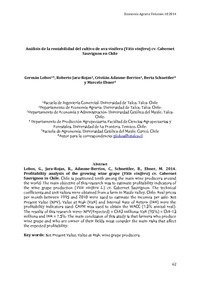Análisis de la rentabilidad del cultivo de uva vinífera (Vitis vinifera) cv. Cabernet Sauvignon en Chile
Autor
Adasme-Berríos, Cristian
Lobos, Germán
Jara-Rojas, Roberto
Schnettler, Berta
Ebner, Marcelo
Fecha
2014Resumen
Chile is positioned tenth among the main wine producers around the world. The main objective of this research was to estimate profitability indicators of the wine grape production (Vitis vinifera L.) cv. Cabernet Sauvignon. The technical
coefficients and unit values were obtained from a farm in Maule valley, Chile. Real prices per month between 1995 and 2010 were used to estimate the incomes per sale. Net Present Value (NPV), Value at Risk (VaR) and Internal Rate of Return (IRR) were the profitability indicators used. CAPM was used to obtain the WACC (7.3% annual real). The results of this research were: NPV(Expected) = Ch$3 millions; VaR (95%) = Ch$-13 millions and IRR = 7,5%. The main conclusion of this study is that farmers who produce wine grape and who are owner of their fields must consider the main risks that affect the expected profitability.
Fuente
Economía Agraria, 18, 62-77Colecciones
La publicación tiene asociados los siguientes ficheros de licencia:


